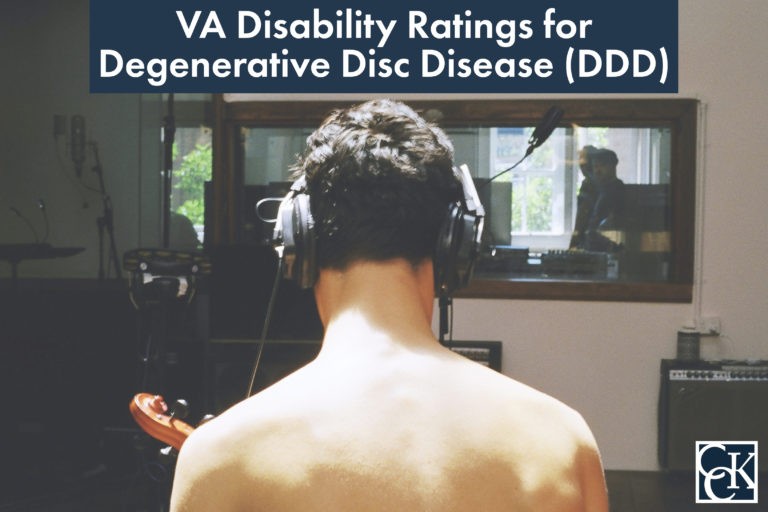VA Disability Ratings for Degenerative Disc Disease (DDD)

What is Degenerative Disc Disease (DDD)?
Degenerative disc disease typically affects the lower back or neck. The condition occurs when the discs between vertebrae lose cushioning, fragment, and herniate.
Many factors can lead to DDD, including heavy lifting, family history of spine problems, or spine injury. Military activities, like repeated heavy lifting, can result in degenerative disc disease over time.
Degenerative disc disease is often accompanied by varying levels of pain. It can also result in numbness and tingling in the upper or lower extremities. Tingling and numbness may not last for long periods of time; however, these symptoms may be a sign of possible nerve damage.
Common Symptoms of DDD
Degenerative disc disease symptoms vary depending on the person. Some people with DDD may experience no pain while others may experience debilitating pain that inhibits their daily life.
The following are some of the most common symptoms of degenerative disc disease:
- Muscle Tension/Muscle Spasms – Most muscle spasms occur in the lower back or neck.
- Low Back Pain – People with DDD may experience chronic lower back pain. The pain often can spread to the groin, buttocks, and thighs.
- Difficulty/Pain When Sitting – Sitting can cause the discs in the lower back to experience three times more weight than when standing.
- Numbness/Tingling – Numbness and tingling most commonly occurs in the arms and legs.
- Difficulty/Pain When Bending/Lifting/Twisting – Pain can worsen when performing tasks that require bending, lifting, or twisting.
- Pain in Legs or Leg Muscles – DDD can cause pain and weakness in the leg muscles as well as foot drop, meaning difficulty lifting one’s foot. This can be a sign of damage to the nerve root.
Service Connection for Degenerative Disc Disease
Generally, to prove service connection and secure a degenerative disc disease VA rating, veterans need evidence of the following three things:
- An in-service event, injury, or illness;
- A current diagnosis of DDD by a medical professional; and
- A medical nexus, or link, between the in-service event and current diagnosis.
Veterans can submit a claim for VA disability benefits on VA Form 21-526EZ. This can be submitted via mail to the Evidence Intake Center or electronically through VA’s website.
Secondary Service Connection
Some veterans may also develop degenerative disc disease as the result of an already service-connected condition. For example, if you have a service-connected knee condition that causes you to favor one side when you walk, you may develop an altered gait. This uneven shift in weight may then contribute to complications in your lower back. In this way, your DDD was caused by your service-connected knee condition, warranting secondary service connection.
To file for secondary service connection, you will need:
- A medical diagnosis of degenerative disc disease from your doctor; and
- A medical nexus linking the primary condition to the secondary DDD.
Importantly, you do not have to file for secondary conditions at the same time as filing for primary conditions. If your degenerative disc disease develops over time, you can file a claim for secondary service connection when necessary.
Compensation and Pension (C&P) Exams for Degenerative Disc Disease
Sometimes the VA Regional Office (RO) will request you attend a Compensation and Pension (C&P) exam to assess your degenerative disc disease. In this situation, a VA RO will contact you to schedule the exam. It is important to attend your C&P exam once it is scheduled or contact VA to reschedule if necessary. If you do not attend, your claim will likely be denied.
The VA examiner will usually ask questions during the exam to establish whether your condition is related to your military service. The examiner will also often ask about the pain levels associated with your condition and what symptoms you experience. After the exam, the VA examiner will issue an opinion deciding if your DDD is “at least as likely as not” connected to your service.
Degenerative disc disease is known to be a condition that develops over time. VA often denies service connection for degenerative disc disease based on an examiner’s finding that a veteran’s condition is due to normal wear and tear and the natural progression of aging rather than their time in service.
However, if VA examiners arrive at this conclusion, they must provide adequate rationale to support their determination. Otherwise, VA should not rely on it for adjudication purposes. It is not enough for the examiners to simply say that a veteran’s DDD is due to natural progression and aging. Instead, they must also explain why it is not due to other factors, such as service.

VA Disability Rating for Degenerative Disc Disease
VA rates degenerative disc disease under 38 CFR § 4.71a, Schedule of Ratings – Musculoskeletal System, diagnostic code 5242. The rating criteria for this diagnostic code is virtually the same as diagnostic code 5003, which is used to rate degenerative arthritis.
According to VA, if degenerative arthritis is established by X-ray findings, the veteran’s condition will be rated based on limitation of motion under the appropriate diagnostic codes for the specific joint or joints involved. However, if the limitation of motion of the specific joint or joints involved is noncompensable (i.e., 0 percent disabling) under the appropriate diagnostic codes, a rating of 10 percent will be applied for each major joint or group of minor joints affected by limitation of motion.
Finally, in the absence of limitation of motion, a veteran’s degenerative disc disease VA rating will be as follows:
- 10% – with X-ray evidence of involvement of two or more major joints or two or more minor joint groups, with occasional incapacitating exacerbations.
- 20% – with X-ray evidence of involvement of two or more major joints or two or more minor joint groups.
When assigning a disability rating based on the severity of symptoms, VA must consider both anatomical damage and functional loss. Importantly, limitation of motion must be objectively confirmed by findings such as swelling, muscle spasm, or satisfactory evidence of painful motion.
What Is the Maximum Disability Rating for Degenerative Disc Disease?
Despite how much pain the condition causes, the maximum VA disability rating for degenerative disc disease, as mentioned above, is typically 20 percent. However, there are a few ways veterans can increase their DDD VA rating.
For example, DDD can lead to other conditions among veterans, such as:
- Musculoskeletal conditions
- Radiculopathy
- Bulging disc
- Scoliosis
- Spinal stenosis
- Mental health disorders, such as depression and anxiety
- And more.
You can file a disability claim for any secondary symptoms or conditions caused by your service-connected degenerative disc disease. This will effectively increase your VA disability rating.
Extraschedular VA Disability Ratings
In addition, there are times when VA can rate veterans outside of the rating schedule. Extraschedular ratings are assigned when the rating criteria does not accurately reflect a veteran’s level of disability. Usually this happens when a veteran experiences symptoms or limitations that are not considered by the rating schedule. Therefore, VA must determine if the veteran is eligible for a rating higher than the ones set forth by the rating schedule.
This might be the case for a veteran’s DDD, as the highest schedular rating under is only 20 percent. To receive an extraschedular disability rating under 38 CFR § 3.321(b)(1) for degenerative disc disease, the following requirements must be met:
- A veteran must show that “the case presents such an exceptional or unusual disability picture with such related factors as marked interference with employment or frequent periods of hospitalization” that make it impractical for VA to assign a schedular rating.
- The final determination on whether an extraschedular rating is warranted must be made by the VA Undersecretary for Benefits or the Director of Compensation Service.
It is important to note that extraschedular disability ratings are granted on a case-by-case basis and are very specific to each situation.
Did VA Deny Your Claim for Degenerative Disc Disease?
If you filed a claim for DDD and VA denied you benefits, Chisholm Chisholm & Kilpatrick LTD may be able to help you appeal the unfavorable decision. For a free case evaluation, call CCK today at 800-544-9144.
About the Author
Share this Post

